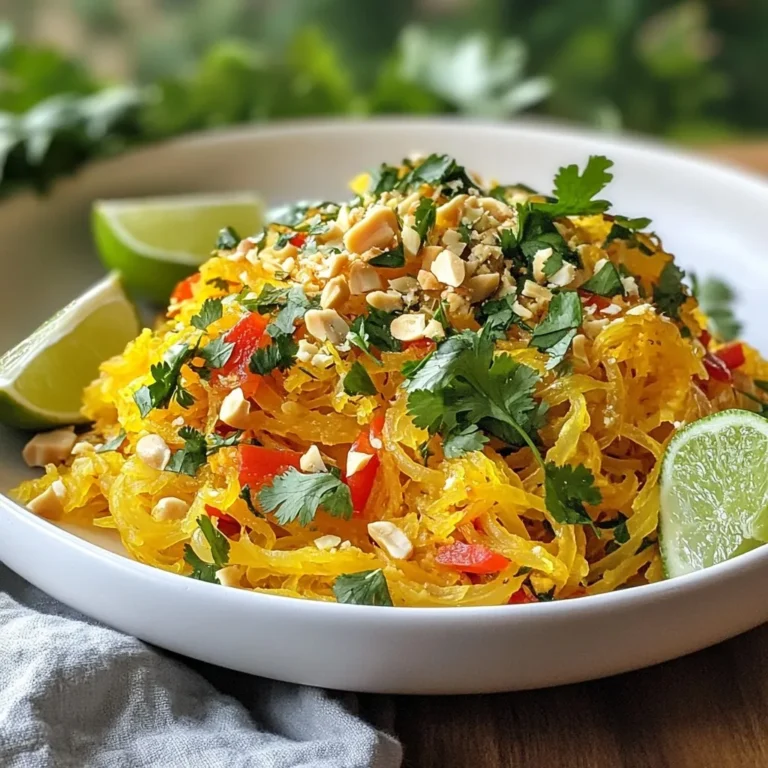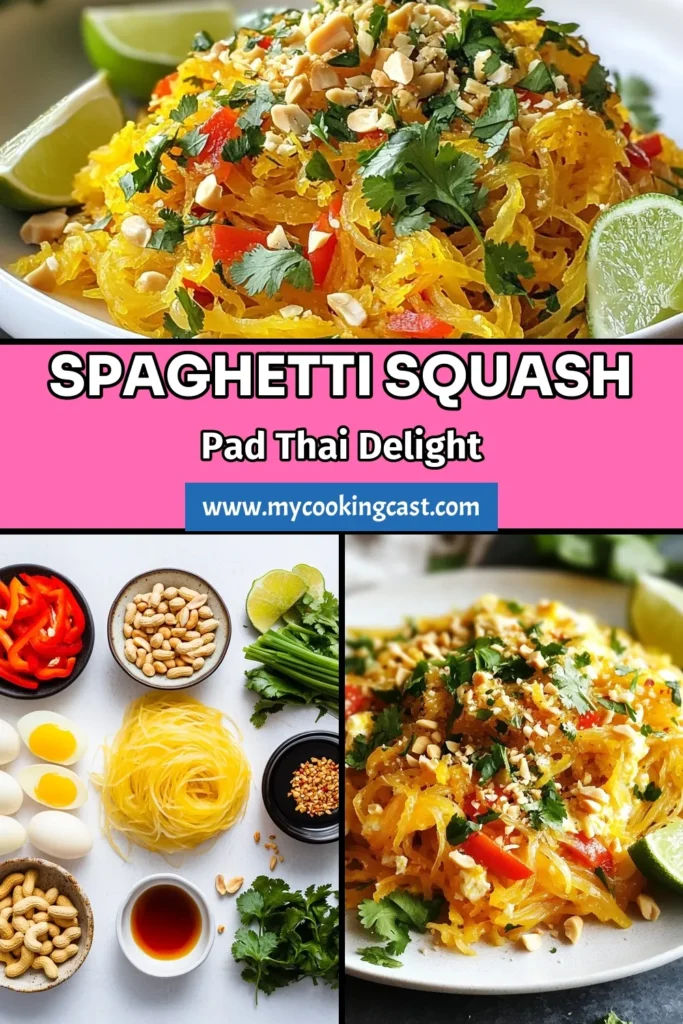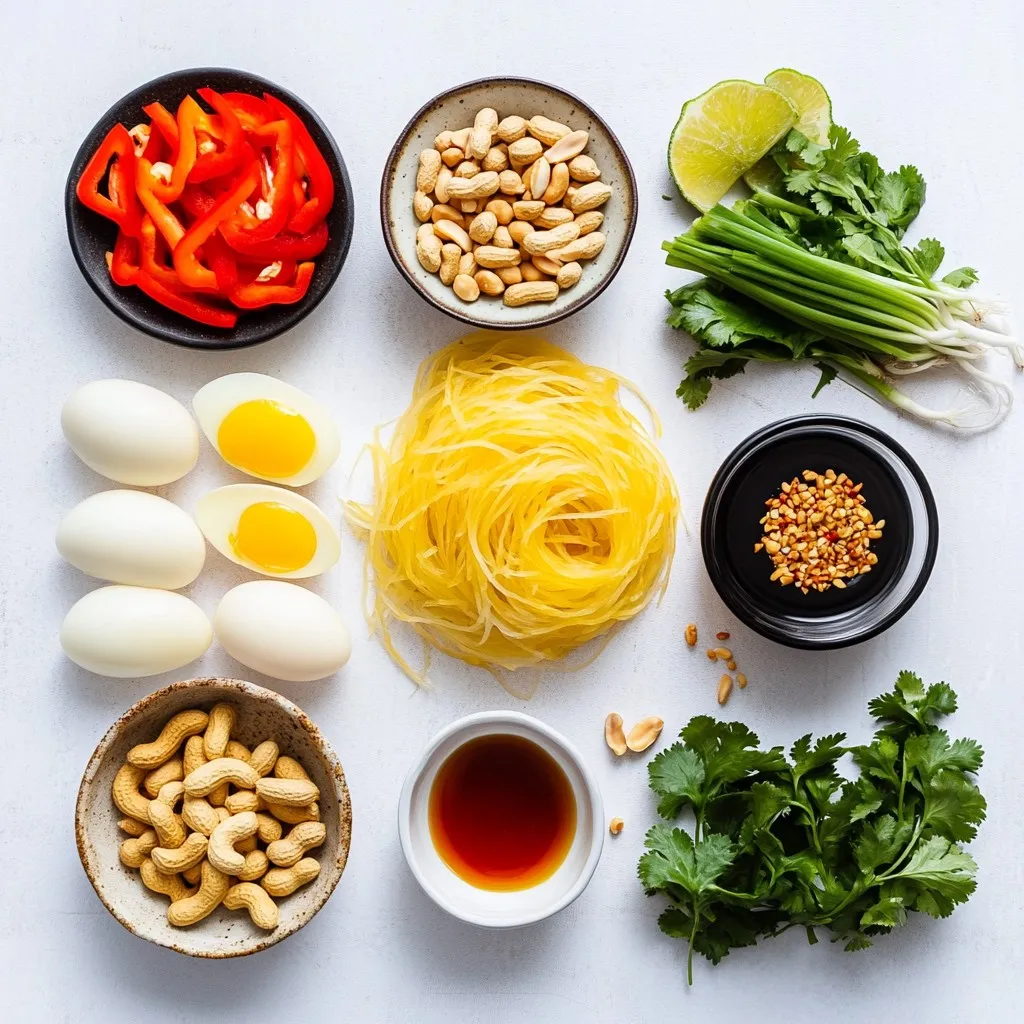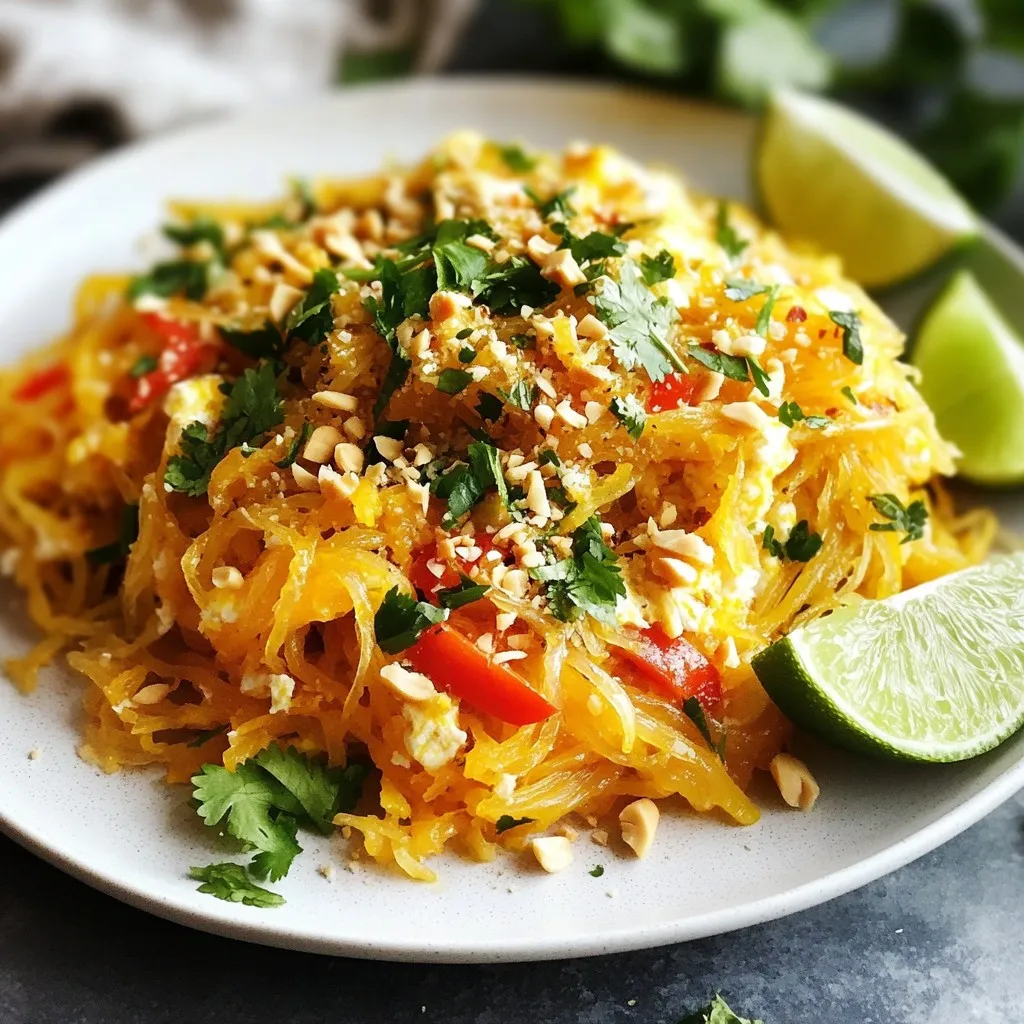WANT TO SAVE THIS RECIPE?
Looking for a healthy twist on a classic dish? My Spaghetti Squash Pad Thai is just what you need! This flavorful and simple delight swaps traditional noodles for spaghetti squash, making it lighter but equally delicious. Packed with fresh veggies, a tasty sauce, and easy steps, you can whip it up in no time. Join me as we explore this satisfying dish that’s perfect for any meal.
Why I Love This Recipe
- Healthy Alternative: This recipe replaces traditional noodles with spaghetti squash, making it a low-carb and nutritious option.
- Quick and Easy: With minimal prep and cooking time, this dish is perfect for busy weeknights.
- Flavor Packed: The combination of peanut oil, tamarind paste, and fresh veggies creates a deliciously vibrant flavor profile.
- Customizable: You can easily add your favorite proteins or adjust the spice level to suit your taste preferences.
Ingredients
Main Ingredients Required
– 1 medium spaghetti squash
– 2 tablespoons peanut oil
– 2 cloves garlic, minced
– 1 red bell pepper, sliced
– 1 cup bean sprouts
– 2 green onions, sliced (white and green parts separated)
– 2 large eggs, lightly beaten
Sauces and Seasonings
– 3 tablespoons soy sauce
– 1 tablespoon tamarind paste
– 1 tablespoon brown sugar
– ½ teaspoon red pepper flakes (adjust to taste)
Garnishes and Serving Suggestions
– Fresh cilantro, for garnish
– Chopped peanuts, for garnish
– Lime wedges, for serving
The ingredients in this Spaghetti Squash Pad Thai make it unique and tasty. First, we use spaghetti squash instead of traditional noodles. This squash is low in carbs and adds a fun texture. The peanut oil is perfect for cooking. It gives a lovely nutty flavor that helps tie the dish together.
Garlic adds a strong and savory taste. The red bell pepper brings color and sweetness. Bean sprouts add crunch, while green onions give a fresh bite. The eggs not only add protein, but they also help bind everything together.
For the sauces, soy sauce brings umami, while tamarind paste adds a tangy twist. Brown sugar balances the flavors with sweetness. Red pepper flakes give a kick, which you can adjust based on your spice level.
Finally, the garnishes are key. Fresh cilantro adds brightness, while chopped peanuts give crunch. Lime wedges add a zesty finish. All these ingredients work together to create a dish that is full of flavor and fun.

Step-by-Step Instructions
Preparing the Spaghetti Squash
– Preheating the oven: Start by preheating your oven to 400°F (200°C). This step is key for even roasting.
– Slicing and seasoning the squash: Carefully slice the spaghetti squash in half lengthwise. Scoop out the seeds. Drizzle the inside with olive oil and season with salt and pepper.
– Roasting instructions: Place the squash cut-side down on a baking sheet. Roast for 35-40 minutes. The squash should be tender and easy to scrape into strands.
Cooking the Pad Thai
– Heating peanut oil and sautéing garlic: In a large skillet or wok, heat 2 tablespoons of peanut oil over medium-high heat. Add 2 minced garlic cloves and sauté for about 30 seconds until fragrant.
– Adding vegetables and stir-frying: Next, add 1 sliced red bell pepper and the white parts of 2 sliced green onions. Stir-fry for 3-4 minutes until the veggies are tender-crisp.
– Scrambling the eggs and mixing: Push the veggies to one side of the skillet. Pour in 2 lightly beaten eggs on the other side. Scramble the eggs until fully cooked, then mix them in with the veggies.
Combining the Ingredients
– Making the sauce: In a small bowl, mix 3 tablespoons of soy sauce, 1 tablespoon of tamarind paste, 1 tablespoon of brown sugar, and ½ teaspoon of red pepper flakes.
– Adding the sauce to the skillet: Pour the sauce over the cooked veggie and egg mixture in the skillet. Stir well to combine.
– Incorporating the spaghetti squash and finishing touches: Turn off the heat and add 1 cup of bean sprouts, mixing until they’re just wilted. Once the spaghetti squash is done, use a fork to scrape it into strands. Add these strands to the skillet and gently toss everything together until heated through.
Tips & Tricks
Selecting the Best Spaghetti Squash
– Look for a squash that feels heavy for its size.
– The skin should be hard with a rich yellow color.
– Avoid squashes with soft spots or blemishes.
Cooking Adjustments
– To change the spice level, add more or less red pepper flakes.
– For a milder dish, skip the red pepper flakes altogether.
– You can swap peanut oil for sesame oil for a different taste.
– Soy sauce can be replaced with tamari for a gluten-free option.
Presentation Tips
– Use a large, shallow bowl to plate your dish.
– Twist the spaghetti strands into nests for a beautiful look.
– Scatter chopped peanuts and cilantro on top for color.
– Add lime wedges on the side for a fresh burst of flavor.
Pro Tips
- Choosing the Right Squash: Look for a spaghetti squash that feels heavy for its size and has a firm skin. This indicates freshness and quality.
- Perfectly Roasted Squash: For even cooking, place the squash cut-side down on the baking sheet to allow steam to circulate while roasting.
- Adjusting Spice Levels: If you prefer less heat, start with fewer red pepper flakes and add more gradually until it reaches your desired spice level.
- Serving Suggestions: For added flavor, serve with a sprinkle of lime juice just before eating to brighten the dish.

Variations
Protein Additions
You can add protein to your Spaghetti Squash Pad Thai. Chicken, shrimp, or tofu work well. For chicken, cut it into small pieces. Cook it in the skillet until it is no longer pink, about 5-7 minutes. Shrimp cooks quickly, about 3-4 minutes until they turn pink. If you prefer tofu, use firm tofu. Cut it into cubes and cook it for 5-6 minutes until golden.
Vegetarian & Vegan Options
If you want a vegetarian or vegan dish, you can skip the eggs. Use scrambled tofu instead. For sauces, replace soy sauce with tamari for gluten-free options. Look for vegan tamarind paste. You can also use nutritional yeast for a cheesy flavor that fits vegan diets.
Flavor Variations
Feel free to play with the veggies in your Pad Thai. Carrots, snap peas, or broccoli add great taste. You can also try different spices. Add ginger for a warm kick or lime juice for zest. Each change can bring a new twist to this classic dish.
Storage Info
Refrigeration Guidelines
Store leftovers in an airtight container. Keep it in the fridge for up to three days. Make sure to let it cool to room temperature first. This helps keep the flavors fresh. I find that separating the sauce from the squash helps maintain texture.
Reheating Recommendations
Reheat in a skillet over medium heat. Stir often to heat evenly. You can also use a microwave. If using the microwave, heat in short bursts. Add a splash of water to keep it moist. This keeps the squash from drying out.
Freezing Spaghetti Squash Pad Thai
To freeze, place in a freezer-safe container. Leave some space for expansion. It can last up to three months. When ready to eat, thaw in the fridge overnight. Reheat in a skillet for best results. You can also use the microwave, but watch the texture.
FAQs
What is Spaghetti Squash Pad Thai?
Spaghetti Squash Pad Thai is a fun twist on the classic dish. Instead of rice noodles, we use spaghetti squash. This squash has a mild flavor and a spaghetti-like texture. The main components include:
– Spaghetti squash
– Peanut oil
– Garlic
– Red bell pepper
– Bean sprouts
– Green onions
– Eggs
These ingredients come together for a tasty and colorful meal. The sauce is made from soy sauce, tamarind paste, brown sugar, and red pepper flakes. This mix gives the dish a sweet, savory, and slightly spicy flavor.
Can I make this recipe gluten-free?
Yes, you can easily make this recipe gluten-free. Use gluten-free soy sauce, which is widely available. For a different flavor, you can try tamari, which is a gluten-free soy sauce. Look for brands that are labeled gluten-free. Always check the labels to be sure.
How do I make this dish ahead of time?
To prepare this dish in advance, you can roast the spaghetti squash first. Store the cooked squash in the fridge. Cook the vegetable and egg mix and store that separately. When you’re ready to eat, just heat both together in a pan. This will keep the flavors fresh.
This blog post covered how to make Spaghetti Squash Pad Thai. We explored key ingredients, sauces, and garnishes. You learned helpful steps for preparing the squash and cooking the dish. Tips on selecting, adjusting, and presenting were shared. Variations for proteins and flavors offer choices for everyone. Lastly, we discussed storage tips to keep your meal fresh. Enjoy making this dish. It’s fun, tasty, and eas
Spaghetti Squash Pad Thai
A healthy twist on traditional Pad Thai using spaghetti squash instead of noodles.
Prep Time 15 minutes mins
Cook Time 40 minutes mins
Total Time 55 minutes mins
Course Main Course
Cuisine Thai
Servings 4
Calories 300 kcal
- 1 medium spaghetti squash
- 2 tablespoons peanut oil
- 2 cloves garlic, minced
- 1 red bell pepper sliced
- 1 cup bean sprouts
- 2 large eggs, lightly beaten
- 3 tablespoons soy sauce
- 1 tablespoon tamarind paste
- 1 tablespoon brown sugar
- 0.5 teaspoon red pepper flakes
- 1 bunch fresh cilantro, for garnish
- 0.5 cup chopped peanuts, for garnish
- 1 lime wedges, for serving
Preheat the oven to 400°F (200°C). Slice the spaghetti squash in half lengthwise and remove the seeds. Drizzle the inside with olive oil and season with salt and pepper. Place cut-side down on a baking sheet. Roast for 35-40 minutes or until the flesh is tender and can be easily scraped with a fork to create strands.
While the squash is roasting, heat the peanut oil in a large skillet or wok over medium-high heat. Add the minced garlic and sauté for about 30 seconds until fragrant.
Add the sliced red bell pepper and the white parts of the green onions to the skillet. Stir-fry for about 3-4 minutes until the vegetables are tender-crisp.
Push the vegetables to one side of the skillet and pour the beaten eggs into the other side. Scramble the eggs until fully cooked, then mix them with the vegetables.
In a small bowl, combine the soy sauce, tamarind paste, brown sugar, and red pepper flakes. Pour this sauce over the cooked vegetable and egg mixture in the skillet, stirring to combine.
Turn off the heat and add the bean sprouts, mixing until they're just wilted.
Once the spaghetti squash is done, use a fork to scrape the flesh into spaghetti-like strands. Add the strands to the skillet and gently toss everything together until well combined and heated through.
Serve the Spaghetti Squash Pad Thai hot, garnished with fresh cilantro, chopped peanuts, and lime wedges on the side.
Adjust the red pepper flakes to your spice preference.
Keyword healthy, pad thai, spaghetti squash, vegetarian
WANT TO SAVE THIS RECIPE?





